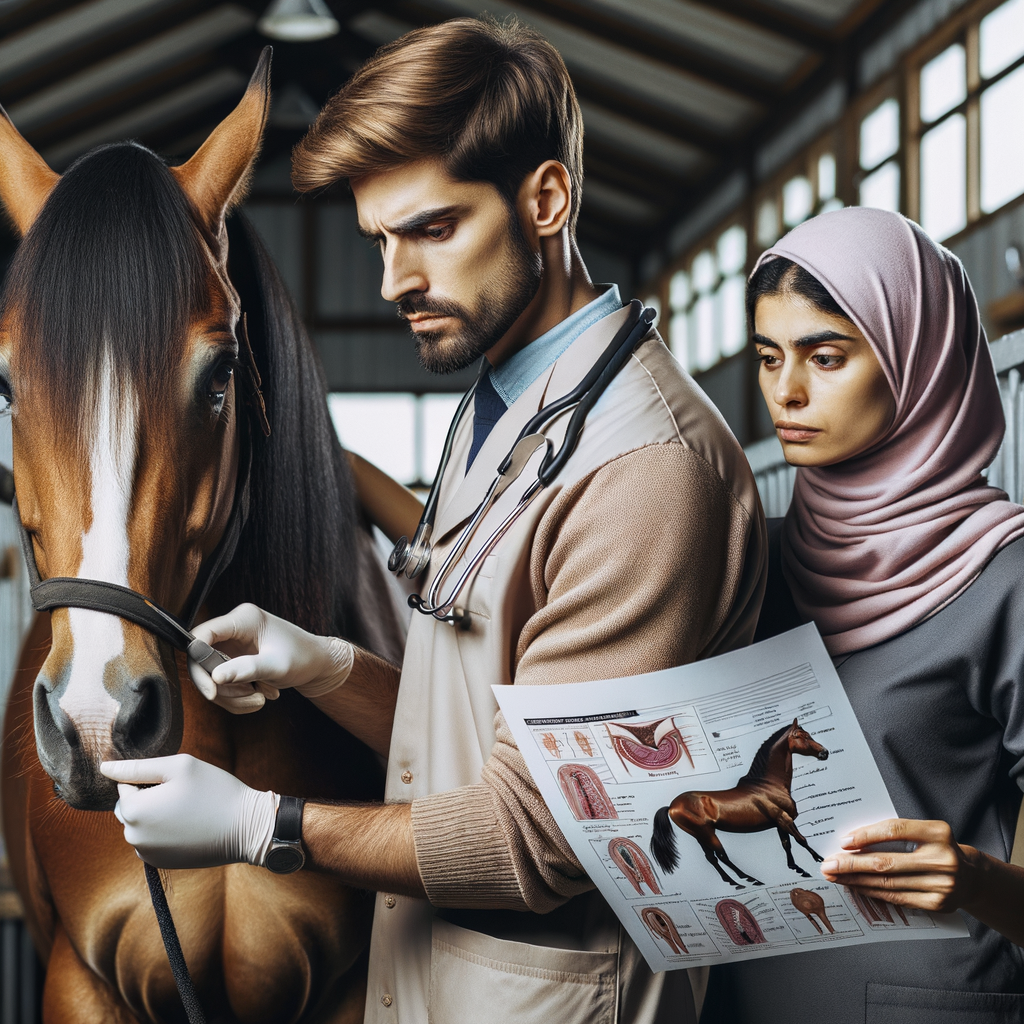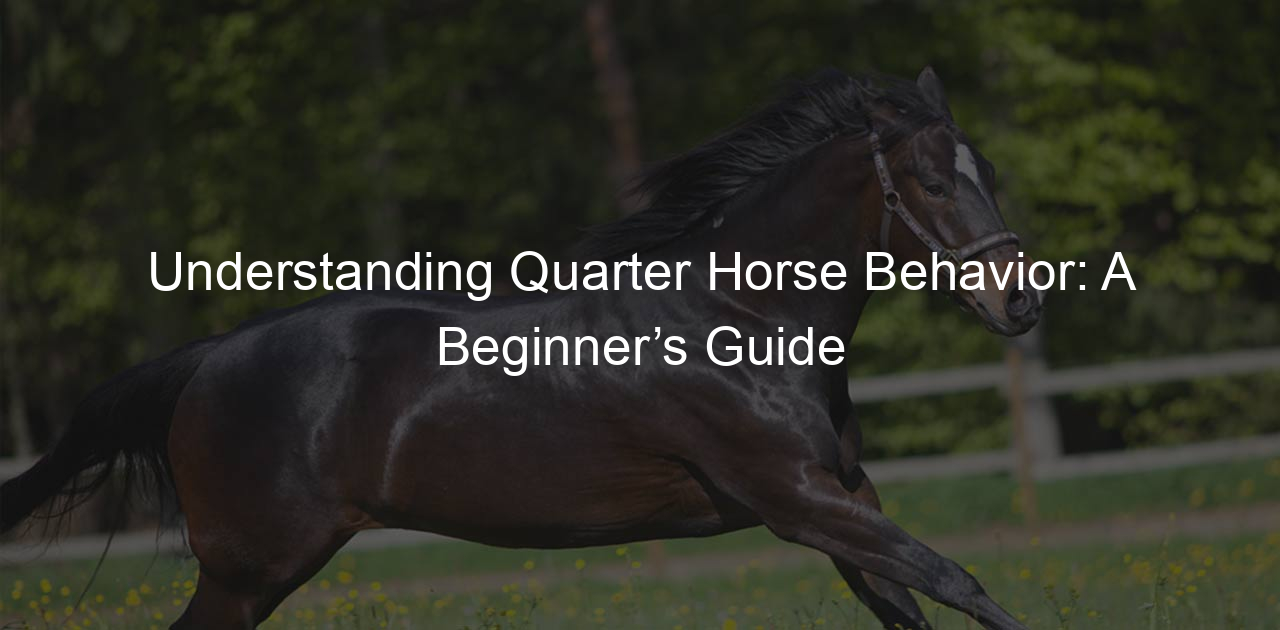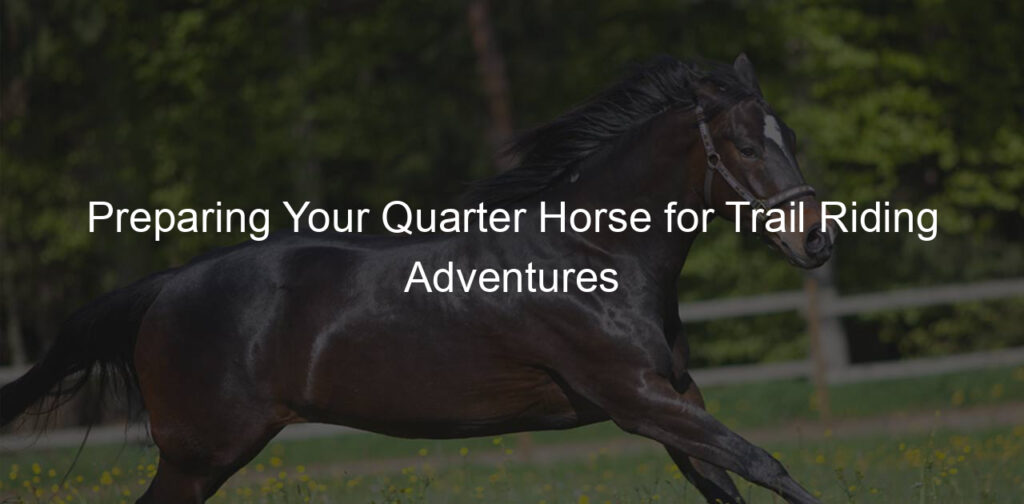
Introduction to Understanding Quarter Horse Reproductive Health
- Importance of reproductive health in Quarter Horses: Reproductive health is crucial for Quarter Horses. It ensures they can breed successfully and maintain good health. Healthy reproduction helps in producing strong and healthy foals, which is vital for the breed’s future.
- Overview of the article: This article will guide you through the essentials of Quarter Horse reproductive health. We will cover topics such as the reproductive system, breeding tips, fertility issues, pregnancy care, and the foaling process. By the end, you will have a clear understanding of how to ensure your Quarter Horse’s reproductive health.
Understanding the Quarter Horse Reproductive System
Quarter Horse Mare Reproductive System
Anatomy and Function
The reproductive system of a Quarter Horse mare includes several key parts. These are the ovaries, fallopian tubes, uterus, cervix, and vagina. Each part has a special job to help the mare reproduce.
Ovaries: The ovaries produce eggs and hormones. These hormones help control the mare’s reproductive cycle.
Fallopian Tubes: These tubes carry the eggs from the ovaries to the uterus.
Uterus: The uterus is where the foal grows during pregnancy. It has a special lining that helps nourish the developing foal.
Cervix: The cervix is a muscular barrier between the uterus and the vagina. It helps protect the uterus from infections.
Vagina: The vagina is the passage through which the foal is born.
Common Reproductive Disorders
Quarter Horse mares can face several reproductive disorders. Knowing about these can help in early detection and treatment.
Endometritis: This is an inflammation of the uterus lining. It can cause infertility if not treated. Symptoms include unusual discharge and prolonged heat cycles.
Ovarian Cysts: These are fluid-filled sacs on the ovaries. They can disrupt the mare’s reproductive cycle. Treatment often involves hormone therapy.
Uterine Infections: Infections in the uterus can be caused by bacteria or fungi. Symptoms include fever, discharge, and discomfort. Early treatment with antibiotics is crucial.
Hormonal Imbalances: These can affect the mare’s ability to conceive. Symptoms include irregular heat cycles and mood changes. Hormone treatments can help balance these issues.
| Disorder | Symptoms | Treatment |
|---|---|---|
| Endometritis | Unusual discharge, prolonged heat cycles | Antibiotics, uterine flushes |
| Ovarian Cysts | Irregular cycles, discomfort | Hormone therapy |
| Uterine Infections | Fever, discharge, discomfort | Antibiotics |
| Hormonal Imbalances | Irregular heat cycles, mood changes | Hormone treatments |
Quarter Horse Stallion Reproductive System
Anatomy and Function
The reproductive system of a Quarter Horse stallion is complex and vital for breeding. It includes several key parts:
| Part | Function |
|---|---|
| Testes | Produce sperm and testosterone. |
| Epididymis | Stores and matures sperm. |
| Vas Deferens | Transports sperm to the urethra. |
| Urethra | Passage for sperm and urine. |
| Penis | Delivers sperm into the mare. |
Each part plays a crucial role in the reproductive process. The testes, for example, are responsible for producing sperm and the hormone testosterone. This hormone is essential for the development of male characteristics and reproductive behavior.
Common Reproductive Disorders
Stallions can face several reproductive issues. Here are some common disorders:
- Testicular Degeneration: This condition affects sperm production and can lead to infertility.
- Cryptorchidism: One or both testes fail to descend into the scrotum. This can cause behavioral issues and infertility.
- Infections: Bacterial or viral infections can impact the reproductive organs, leading to reduced fertility.
- Hormonal Imbalances: Abnormal hormone levels can affect sperm production and libido.
Understanding these disorders is crucial for maintaining a healthy breeding program. Regular veterinary check-ups can help detect and manage these issues early on.
Quarter Horse Breeding Tips
Choosing the Right Time for Breeding
- Understanding the Quarter Horse breeding seasonThe best time to breed Quarter Horses is during the spring and early summer. This period is known as the breeding season. During this time, mares are more likely to conceive because of the longer daylight hours. According to experts, mares have a higher fertility rate when they are exposed to more light.
It’s important to plan breeding during this season to increase the chances of a successful pregnancy. Breeding outside this period can lead to lower conception rates and other complications.
- Signs of readiness for breeding in mares and stallionsKnowing when your mare or stallion is ready for breeding is crucial. Here are some signs to look for:
- Mares: Mares show signs of heat, such as frequent urination, restlessness, and a raised tail. They may also become more affectionate towards stallions.
- Stallions: Stallions become more active and vocal. They may also show increased interest in mares and exhibit behaviors like prancing and neighing.
Observing these signs can help you determine the best time to breed your horses. Always consult with a veterinarian for professional advice.
Ensuring Successful Breeding
-
Quarter Horse Reproductive Management
Proper reproductive management is key to successful breeding. Here are some important steps:
- Health Check: Ensure both the mare and stallion are healthy. Regular vet check-ups are crucial.
- Nutrition: A balanced diet helps maintain reproductive health. Include vitamins and minerals.
- Environment: Provide a clean and stress-free environment. This helps in better conception rates.
- Record Keeping: Keep detailed records of breeding dates, health checks, and any treatments.
According to a study, mares with good reproductive management have a 20% higher conception rate. Learn more about equine reproduction.
-
Common Mistakes to Avoid
Avoiding common mistakes can improve breeding success. Here are some pitfalls to watch out for:
- Poor Timing: Breeding at the wrong time can lead to failure. Understand the mare’s cycle.
- Inadequate Nutrition: Poor diet affects fertility. Ensure a balanced diet.
- Ignoring Health Issues: Overlooking health problems can reduce conception rates. Regular vet visits are essential.
- Stressful Environment: Stress can negatively impact breeding. Keep the environment calm and clean.
For instance, a case study showed that mares in low-stress environments had a 15% higher success rate in breeding.
| Factor | Importance |
|---|---|
| Health Check | High |
| Nutrition | High |
| Environment | Medium |
| Record Keeping | Medium |
Quarter Horse Fertility Issues
Common Fertility Issues in Mares
- Causes and solutions:Fertility issues in mares can be caused by various factors. Some common causes include hormonal imbalances, infections, and poor nutrition. To address these issues, it’s important to work closely with a veterinarian. Regular check-ups, a balanced diet, and proper hygiene can help improve fertility.
Cause Solution Hormonal Imbalances Hormone therapy as prescribed by a vet Infections Antibiotics and proper hygiene Poor Nutrition Balanced diet with essential vitamins and minerals -
Case study: Overcoming fertility issues in a mare:
One mare, named Bella, faced fertility problems due to an infection. Her owner worked with a vet to treat the infection with antibiotics. Along with this, Bella was given a special diet to boost her overall health. After a few months, Bella successfully conceived and gave birth to a healthy foal.
“Bella’s journey shows that with the right care and attention, fertility issues can be overcome.” – Dr. Smith, Veterinarian
Common Fertility Issues in Stallions
-
Causes and Solutions
Fertility issues in stallions can arise from various causes. Some common causes include:
- Genetic Factors: Some stallions may inherit fertility problems from their parents.
- Age: Older stallions may experience a decline in fertility.
- Infections: Infections in the reproductive organs can affect fertility.
- Injuries: Physical injuries to the reproductive organs can cause issues.
- Nutrition: Poor diet can lead to fertility problems.
Solutions to these issues include:
- Veterinary Care: Regular check-ups can help detect and treat infections early.
- Proper Nutrition: A balanced diet can improve overall health and fertility.
- Genetic Testing: Testing can help identify genetic issues early on.
- Injury Prevention: Proper handling and care can prevent injuries.
-
Case Study: Overcoming Fertility Issues in a Stallion
Meet Thunder, a 10-year-old Quarter Horse stallion. Thunder had been experiencing fertility issues for over a year. His owner noticed a decline in his breeding success rate.
After a thorough veterinary examination, it was discovered that Thunder had a mild infection in his reproductive organs. The vet prescribed antibiotics and recommended a diet rich in vitamins and minerals.
Within a few months, Thunder’s condition improved significantly. His breeding success rate increased, and he was back to his healthy self.
This case highlights the importance of regular veterinary care and proper nutrition in maintaining stallion fertility.
Quarter Horse Pregnancy Care
Proper Nutrition During Pregnancy
- Importance of NutritionNutrition is very important for pregnant Quarter Horse mares. Proper nutrition helps the mare stay healthy and supports the growth of the foal. A well-fed mare is more likely to have a smooth pregnancy and a healthy foal.
- Recommended Diet for Pregnant Quarter Horse MaresPregnant mares need a balanced diet. Here are some key components:
- Forage: Good quality hay or pasture should be the main part of the diet.
- Grains: Grains like oats or barley can provide extra energy.
- Vitamins and Minerals: Supplements may be needed to ensure the mare gets enough vitamins and minerals.
- Water: Always provide fresh and clean water.
Consult with a vet to create the best diet plan for your pregnant mare.
Regular Check-ups and Vaccinations
- Importance of regular veterinary check-upsRegular check-ups with a vet are crucial for pregnant Quarter Horse mares. These visits help ensure the mare and her foal are healthy. Vets can catch problems early, which makes them easier to treat.
For example, a vet can check for signs of infections or other health issues. Early detection can prevent complications during pregnancy and foaling. According to Wikipedia, regular veterinary care improves the overall health of animals.
- Essential vaccinations for pregnant maresVaccinations are vital to protect pregnant mares and their unborn foals from diseases. Some key vaccines include:
- Tetanus: Protects against a serious bacterial infection.
- Equine Herpesvirus (EHV-1): Prevents respiratory and reproductive issues.
- Influenza: Guards against flu-like symptoms in horses.
These vaccinations help ensure the mare stays healthy throughout her pregnancy. They also protect the foal after birth. A healthy mare is more likely to have a healthy foal.
| Check-up | Frequency | Purpose |
|---|---|---|
| General Health Check | Every 4-6 weeks | Monitor overall health and catch issues early |
| Ultrasound | As recommended by vet | Check foal development |
| Vaccinations | As per vaccination schedule | Prevent diseases |
Quarter Horse Foaling Process
Signs of Impending Foaling
As the time for foaling approaches, it’s important to recognize the signs that indicate your Quarter Horse is ready to give birth. Understanding these signs can help you prepare and ensure a smooth foaling process.
-
Physical and behavioral signs:
- Udder development: The mare’s udder will start to fill with milk, usually 2-4 weeks before foaling.
- Waxing teats: A waxy substance may appear on the teats 1-2 days before foaling.
- Restlessness: The mare may become more restless and frequently lie down and get up.
- Changes in appetite: Some mares may eat less as they get closer to foaling.
-
Preparing for the foaling process:
- Clean environment: Ensure the foaling area is clean and free of hazards.
- Monitoring: Keep a close watch on the mare, especially during the last few weeks of pregnancy.
- Veterinary contact: Have your veterinarian’s contact information handy in case of emergencies.
- Foaling kit: Prepare a foaling kit with essential items like clean towels, iodine, and a flashlight.
| Sign | Description |
|---|---|
| Udder development | The mare’s udder fills with milk 2-4 weeks before foaling. |
| Waxing teats | A waxy substance appears on the teats 1-2 days before foaling. |
| Restlessness | The mare frequently lies down and gets up. |
| Changes in appetite | The mare may eat less as foaling nears. |
Recognizing these signs and preparing accordingly can help ensure a safe and successful foaling process for your Quarter Horse.
Stages of the Foaling Process
-
Understanding the stages
Foaling, or the birth of a foal, happens in three main stages. Knowing these stages helps ensure the health of both mare and foal.
| Stage | Description |
|---|---|
| Stage 1 | The mare shows signs of discomfort. She may sweat, pace, or lie down and get up often. This stage can last a few hours. |
| Stage 2 | This is the actual birth. The mare will lie down, and the foal will be born. This stage is usually quick, lasting 15-30 minutes. |
| Stage 3 | The mare passes the placenta. This should happen within 3 hours after the foal is born. |
-
What to do during each stage
Knowing what to do during each stage is crucial for a successful foaling process.
-
- Stage 1: Keep the area quiet and calm. Monitor the mare closely but do not interfere.
- Stage 2: Ensure the mare is in a clean, safe space. If the foal is not born within 30 minutes, call a vet.
- Stage 3: Check that the placenta is fully passed. If not, contact a vet immediately.
Conclusion: Ensuring Healthy Reproduction in Quarter Horses
Ensuring healthy reproduction in Quarter Horses is vital for maintaining their well-being and lineage. By understanding their reproductive system, following breeding tips, addressing fertility issues, and providing proper pregnancy and foaling care, you can help your horses thrive.
-
Key takeaways from the article:
-
- Understanding the reproductive system of Quarter Horses is essential.
- Proper breeding techniques can improve success rates.
- Addressing fertility issues early can prevent complications.
- Providing adequate pregnancy care ensures the health of both mare and foal.
- Being prepared for the foaling process helps in managing any emergencies.
-
Importance of continued learning and research:
- Stay updated with the latest research and techniques in horse breeding.
- Consult with veterinarians and equine experts regularly.
- Join forums and groups dedicated to Quarter Horse care and breeding.
- Read scientific journals and articles to enhance your knowledge.
By following these guidelines and continually educating yourself, you can ensure the healthy reproduction of your Quarter Horses, contributing to their longevity and the overall quality of the breed.
| Aspect | Key Points |
|---|---|
| Reproductive System | Understand anatomy and function. |
| Breeding Tips | Use proven techniques and monitor closely. |
| Fertility Issues | Identify and address problems early. |
| Pregnancy Care | Provide proper nutrition and veterinary care. |
| Foaling Process | Be prepared and know what to expect. |
The health and well-being of your Quarter Horses depend on your commitment to their care. Keep learning and stay proactive to ensure their successful reproduction.









